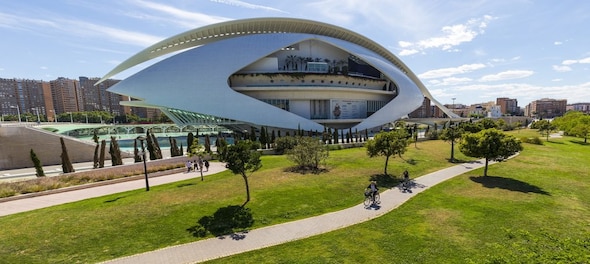
A gigantic eye with aluminium awnings that fold collectively to reveal the iris. A harp-like stringed bridge that I wanted to pluck for a dulcet sound. A mammoth concrete water lily washed ashore. A helmet with a feather. The skeleton of a whale taut and enchanting. Standing in Valencia’s sunken river bed, the futuristic buildings of the City of Arts and Sciences seem straight out of an alien planet’s housing project.
The opera, the theatre, the interactive science museum, the floating structures in which live the cypress, hemmed by a turquoise pool. All designed by Valencia’s famous architect Santiago Calatrava on the dry bed of River Turia which was deliberately diverted after a catastrophic flood in 1957.
In the Spanish city that was founded in 138 BC by the Romans, the City of Arts and Sciences is the mesmeriser. Jaw-dropped looking at the unusual structures that are now tagged one of the 12 Treasures of Spain. The City is modern in its idiom, a stark contrast to the Old Town Valencia where old squares, gargoyles, Gothic churches, blind alleys and grand palaces have stood still for ages – from the earliest Roman settlers to the Moors who conquered the area in 718 AD and made it their home until 1238 AD. The Moors brought rice, saffron, oranges, silk – all that Valencia is famed for.
But it was not the Moors but Lord Shiva’s name that first echoed in Valencia’s Rice Museum. The 11-minute documentary began with the story of Lord Shiva and a maiden called Retua Dumila who requested Shiva to find a food that she would never tire of. The god’s messengers huffed and puffed around the universe but could not find that food. Disheartened, Retua died. On the 40th day of her death, an unknown plant rose from her grave, it was paddy, the food that Retua wanted.
That rice-origin story acquires added significance because paella, Spain’s most famous dish, was born by Albufera Lake in Valencia. Borrowing its name from the pan in which it is cooked, the original paella recipe included chicken, rabbit, green beans, lima beans, tomato, rice (with a València Denomination of Origin), olive oil, water, saffron, garlic and salt. So important is paella to the Spanish that March 27 has been designated National Paella Day.
Having eaten the paella with a wooden stone (that is how a paella is eaten) and stuffed to the gill, I had to seek forgiveness for gluttony. So many churches. But first I had to deal with an alligator sleeping languorously over a holy basin in Colegio del Patriarca. The Dragon of the Patriarch, an alligator that was once a monk’s pet.
Inside lay splendid frescoes but I walked away from the alligator and sculpted bats hanging from every ledge and balustrade to see the Holy Grail, the chalice that Jesus Christ is said to have used at the last supper. Worldwide, there are many claimants to the ‘real’ Holy Grail, but the Valencian chalice, a cup hewn from agate and polished with myrrh, tops the ‘real’ list. I sought forgiveness for the paella greed as the hideous gargoyles chuckled from the church stone walls.
As I stepped towards the Silk Exchange, a UNESCO World Heritage Site, the clouds tore open and fat raindrops got caught in my long hair. I hurried to the old staircase of the Exchange. A raindrop hurtled down my face and I remembered Spanish poet Miguel Hernandez’s “Cold lurches forward and death’s leaves fall dead. A soundless din I hear rains here below where on the white snow, life is red and red sets the snow steamy, sows fire in the snow…”
That day in Valencia, no one was sowing fire in the snow. Around me lay valour. Poetry. History. And the warmth of an old city.
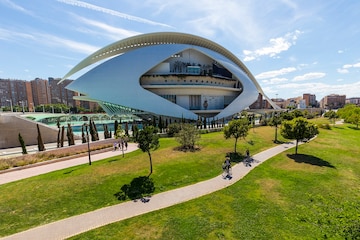 The City of Arts and Sciences: An ensemble of six buildings designed by famed Valencian architect Santiago Calatrava.
The City of Arts and Sciences: An ensemble of six buildings designed by famed Valencian architect Santiago Calatrava.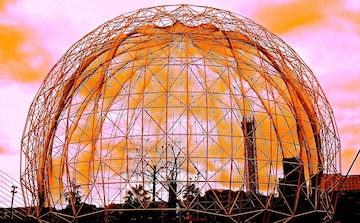 The Aviary in the City of Arts and Sciences housed next to the Oceanografic, the largest aquarium in Europe which was designed by architect Félix Candela.
The Aviary in the City of Arts and Sciences housed next to the Oceanografic, the largest aquarium in Europe which was designed by architect Félix Candela.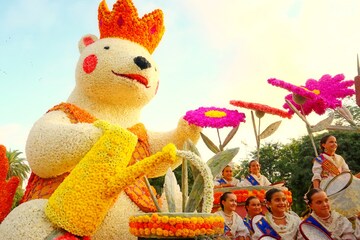 Falles Festival, the most famous festival of Valencia is a traditional celebration held in commemoration of Saint Joseph. The term ‘Falles’ refers to both the celebration and the monuments burnt during the celebration. In 2016, the Falles Festival was added to UNESCO’s Intangible Cultural Heritage of Humanity List.
Falles Festival, the most famous festival of Valencia is a traditional celebration held in commemoration of Saint Joseph. The term ‘Falles’ refers to both the celebration and the monuments burnt during the celebration. In 2016, the Falles Festival was added to UNESCO’s Intangible Cultural Heritage of Humanity List.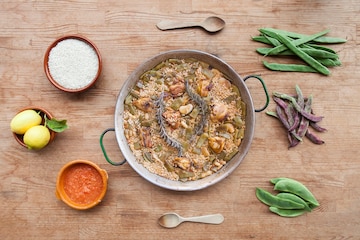 Rice was brought to Valencia by the Moors in the 10th century and paella, Spain’s most popular dish, was born in the city of Valencia. March 27 is celebrated as National Paella Day.
Rice was brought to Valencia by the Moors in the 10th century and paella, Spain’s most popular dish, was born in the city of Valencia. March 27 is celebrated as National Paella Day.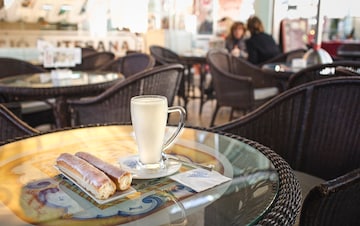 Horchata, a summer drink made of tiger nut and sugar and usually served with fartons (sweet elongated bread). A regulating council exists in Spain to ensure the quality and traceability of the product in relation to the Designation of Origin.
Horchata, a summer drink made of tiger nut and sugar and usually served with fartons (sweet elongated bread). A regulating council exists in Spain to ensure the quality and traceability of the product in relation to the Designation of Origin.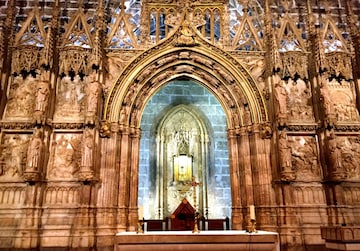 The Metropolitan Cathedral-Basilica of the Assumption of Our Lady of Valencia houses the Holy Grail, the chalice that Jesus Christ is said to have used at the last supper.
The Metropolitan Cathedral-Basilica of the Assumption of Our Lady of Valencia houses the Holy Grail, the chalice that Jesus Christ is said to have used at the last supper.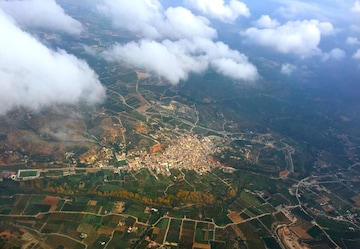 A bird’s eye view of Valencia, a Spanish city which was founded as a Roman colony in 138 BC.
A bird’s eye view of Valencia, a Spanish city which was founded as a Roman colony in 138 BC.Photo credit:
Preeti Verma Lal and Valencia Tourism.
Preeti Verma Lal is a Goa-based freelance writer/photographer.
First Published: Nov 30, 2018 5:37 PM IST
Check out our in-depth Market Coverage, Business News & get real-time Stock Market Updates on CNBC-TV18. Also, Watch our channels CNBC-TV18, CNBC Awaaz and CNBC Bajar Live on-the-go!


Colour-coordinated theme-based polling booths set up in Srinagar
May 10, 2024 9:26 AM
Haryana: 16 women among 223 candidates in fray for 10 Lok Sabha seats
May 10, 2024 9:04 AM

